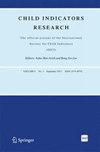Conceptualising and Measuring Adolescents’ Hedonic and Eudemonic Wellbeing: Discriminant Validity and Dimensionality Concerns
IF 2.1
3区 社会学
Q1 SOCIAL SCIENCES, INTERDISCIPLINARY
引用次数: 0
Abstract
There is a gap between the theoretical assumptions of wellbeing and its associated empirical constructs. Three measurement models (a correlated factors model, a second-order two-factor model, and a bifactor model) were analysed using a large sample of English adolescents (n = 37, 630) to test whether the theoretical separation between hedonic and eudemonic wellbeing is empirically supported, and whether there is the possibility of essential unidimensionality. Evidence of a general factor of wellbeing was found in the bifactor model, challenging the de-facto distinction often made between hedonic and eudemonic wellbeing.
青少年享乐和情趣幸福的概念化和测量:区分度和维度问题
摘要 幸福感的理论假设与其相关的经验构建之间存在差距。我们使用大量英国青少年样本(n = 37,630)分析了三种测量模型(相关因素模型、二阶双因素模型和双因素模型),以检验理论上将享乐型幸福感与优裕型幸福感分开是否得到了经验支持,以及是否存在基本单维的可能性。在双因素模型中发现了幸福感的一般因素的证据,这对通常在享乐型幸福感和享乐型幸福感之间做出的事实上的区分提出了挑战。
本文章由计算机程序翻译,如有差异,请以英文原文为准。
求助全文
约1分钟内获得全文
求助全文
来源期刊

Child Indicators Research
SOCIAL SCIENCES, INTERDISCIPLINARY-
CiteScore
4.90
自引率
14.30%
发文量
103
期刊介绍:
Child Indicators Research is an international, peer-reviewed quarterly that focuses on measurements and indicators of children''s well-being, and their usage within multiple domains and in diverse cultures. The Journal will present measures and data resources, analysis of the data, exploration of theoretical issues, and information about the status of children, as well as the implementation of this information in policy and practice. It explores how child indicators can be used to improve the development and well-being of children. Child Indicators Research will provide a unique, applied perspective, by presenting a variety of analytical models, different perspectives, and a range of social policy regimes. The Journal will break through the current ‘isolation’ of academicians, researchers and practitioners and serve as a ‘natural habitat’ for anyone interested in child indicators. Unique and exclusive, the Journal will be a source of high quality, policy impact and rigorous scientific papers. Readership: academicians, researchers, government officials, data collectors, providers of funding, practitioners, and journalists who have an interest in children’s well-being issues.
 求助内容:
求助内容: 应助结果提醒方式:
应助结果提醒方式:


